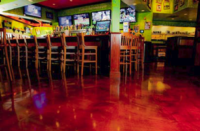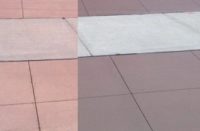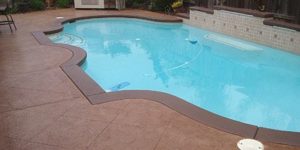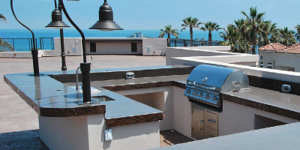Integral colors don’t fade, but over time, integrally colored surfaces can start to look dingy. Understanding why, and what to do about it, is just the beginning of getting a handle on color maintenance.
In 1915, Lynn Mason Scofield, the man who gave his name to L.M. Scofield Co., introduced his company’s first concrete coloring techniques. His products included color hardeners, integral color, sealers and chemical stains. Colored concrete has grown in popularity ever since.
But while colored concrete has been used in commercial construction for years, its popularity in private residences has grown significantly over the last several years. It is no longer unusual to stroll up a colored concrete walkway to a private residence, knock on the door and enter to find that the floor, countertops, patio and garage floor have all utilized colored concrete construction.
With the growth in popularity, it probably comes as no surprise that customer expectations have risen as well. The uninitiated often view concrete as an impervious product that will remain unchanged for hundreds of years. And can we really blame them? Concrete is all around us, and much of it has been in place for decades. Why wouldn’t a homeowner or businessperson assume that colored concrete in a home or office will last for centuries?
They will assume just that, and be shocked by reality, unless the concrete contractor tells them the truth: Colored concrete may require some maintenance and care to keep looking fresh.
Glen Roman, owner of Staintec Decorative Concrete Systems, of Rancho Cucamonga, Calif., and director of training for stain manufacturer Newlook International Inc., notes that decorative concrete has transitioned from very high-end applications to what is now mainstream. Contractors have to transition too.
A lot of contractors don’t communicate well with their customers, Roman says. “I find a lot of contractors don’t really discuss the product choices that are available or the application techniques they will be using with their customers until it’s too late,” he says. “Then it becomes an issue. You always want to have a straightforward, honest discussion with your client about product or application expectations regarding overall appearance, color combinations, longevity and so on.”
Clear communication is an advantage, he says. “I don’t sugarcoat it. I tell them plain and simple right up front, that (for example) ‘Your colored concrete will require periodic maintenance’ at their discretion. And they tend to accept that.”
Good advice, but the devil is in the details. How much explanation is too much? How much is not enough? If the contractor has a clear understanding of what kind of end result the customer wants, is it really all that critical that the client understand the differences between dyes and water-based stains, integral coloring or acid stains? Do they need to understand efflorescence and water migration, or the difference in acrylic and polyurethane sealers vs. a wax topcoat?
They do, Roman says. “I try to explain the products and processes to the customer, and I let them make a educated decision on what is most cost-effective for their project.”
Fade to gray
Chris Sullivan of QC Construction Products says that when it comes to restoring colored concrete, there are a lot of things to consider. “A myriad of products can be used,” he says, “and you really need to ask the customer questions like, ‘How much do you want to spend and how long do you want it to last?’” For instance, if the customer simply desires a quick fix, a relatively inexpensive colored curing compound may be in order.
One should also consider the environment, which the concrete will continue to weather. “Stains are more UV-stable, while organic-based dyes tend to fade with exposure to the sun,” Sullivan says. He recommends grinding or chemically removing the top layer of an exterior colored slab and then utilizing acid-based, salt-based or solid-based stain.
Determining the cause of fading is critical. It’s an especially complex question when considering integrally colored concrete. “(The appearance of) fading in integrally colored concrete may be the result of weather, traffic, moisture and efflorescence, individually or in any combination,” Sullivan says.
Most homeowners and even some contractors don’t understand that iron oxide pigments in concrete don’t break down or fade, Roman says. Despite the facts, alleged integral fading is one of the oldest complaints among customers, he says. The fact that most standard colored concrete jobs aren’t sealed doesn’t improve the situation.
“If you wet the concrete, you can easily see that the colors haven’t changed,” he says. “It’s the minerals around the color that change the look. Consequently, the surface appears to be chalky or hazy. And the customer is unhappy. If they choose to, sealing the concrete will enhance the look and can easily restore the once-vibrant color.”
Fading is most often due to surface effects, Sullivan says. “So if the sealer is maintained, coloring shouldn’t fade.”
James L. Schwartz, president of Concreteworksdesign in Norman, Okla., agrees. “Outside colors don’t typically fade,” he says. “The culprit of a dull and faded slab is usually sealer-related. Most good quality 30-to-40-percent solids sealers can take a great amount of abuse, but there is a limit.”
In Oklahoma, moisture is a persistent problem in colored concrete, he says. “We experience extremes in weather in this part of the country. Our clay soils are like a sponge, and they ebb and flow below the surface, resulting in unpredictable and at times rapid moisture migration. This rapid moisture migration brings about excessive minerals being trapped within the sealer itself, commonly called efflorescence, leaving a cloudy, chalky look and ultimately no color.”
Another factor regarding moisture and concrete is that concrete is typically alkaline, James says. “The rapid rising and high amounts of moisture rising through the slab lead to a high surface pH, which will aggravate most water-based colors or sealers and in some cases cause pigment delamination.”
Even when moisture is the cause, the methodology for repair is basically the same — remove the sealer, restain or re-dye if necessary, and apply new sealer. Schwartz uses citrus-based or alkaline strippers to remove most sealers. Tests help him determine the appropriate sealer, usually a modified acrylic. Lower-solids acrylics (15 to 25 percent) typically last about 12 to 18 months, he says, while modified acrylics (25 to 40 percent) last three to five years. “Some UV-protected polys are doing well at five years now,” he notes.
Looking out for the client
Roman and Reid Langston, president and CEO of Newlook International, claim that their Newlook products provide an easy and cost-efficient fix for restoring colored concrete. “Newlook is designed to oxidize without calcification,” Roman says. “So, it transitions to a nice finish with consistent color and a natural look.”
But even with Newlook, Langston says communicating is key. “There is really no sense in repairing colored concrete without first having a detailed discussion with the customer about warranties and maintenance,” he says. “What we try to do, and what we explain to our customers, is to extend the life of a product in a way that will increase the longevity of the concrete and minimize future maintenance needs while maintaining an ecologically responsible approach.”
Schwartz and Roman subscribe to the green approach as well. Both utilize green products as often as possible, and Schwartz stresses collection and disposal when a project requires the use of acids and environmentally unfriendly driver agents.






















